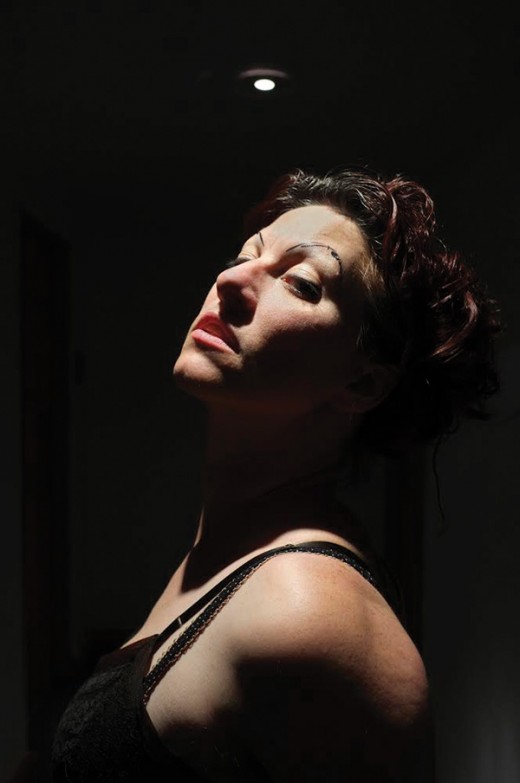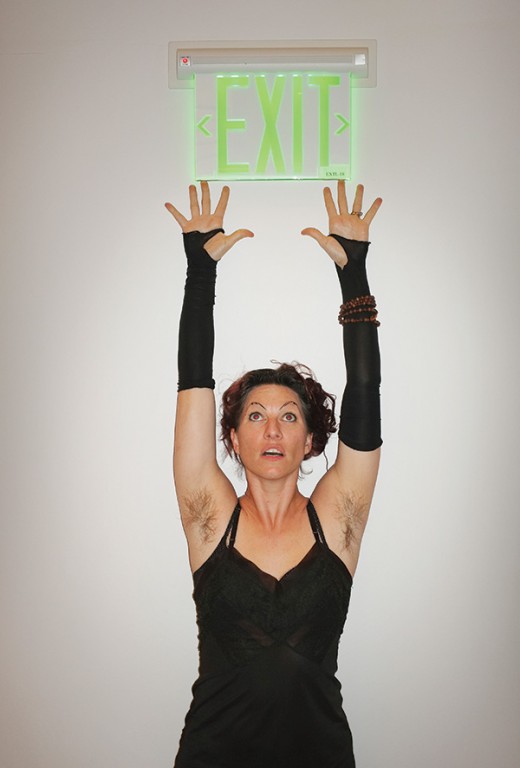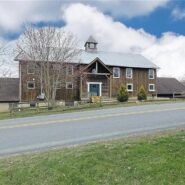Life Is a Cabaret: Amanda Palmer’s “The Bed Show” Debuts at Bard College This Week
Peter Aaron | November 6, 2014
Photo by Fionn Reilly
Editor’s note: Chronogram and Upstate House editor Peter Aaron profiled artist, performer, musician (and HV local) Amanda Palmer — debuting an original musical at Bard’s Fisher Center for the Arts this week — in this month’s issue of the magazine, and we are delighted to pass it along…
We first encounter Amanda Palmer at a local bar. She’s scrunched up quietly in a corner. Loud music and revelry swirl around her stool, where she’s intently perched, facing the wall—pen in her hand, draft beer at her side. If anyone else in here recognizes the celebrated solo artist and front woman of the Dresden Dolls, they’re letting her be. And that’s fine. She’s not here to sign autographs, or to party. Instead, the manuscript of her new book, The Art of Asking (Grand Central Publishing), designed to “inspire readers to rethink their own ideas about asking, giving, art, and love,” lies spread open before her. Palmer, engrossed in its pages, is here to edit the thing. For a music editor used to the tomb-like solitude of his hermetically sealed garret, the thought of attempting to work within the eye of such a Koyaanisqatsi-esque hurricane brings vertigo and nausea.
“Oh, I’ve always written in bars and cafès,” Palmer says casually a few weeks later. “I work well around the energy of people.”
Whatever environments Palmer chooses in which to create her art, which includes not only includes her music and other books but also numerous theatrical productions and performance art projects, they’ve clearly been conducive. One of today’s most thought-provoking indie icons, Palmer regularly headlines theater-scale venues around the world and is the recipient of racks of awards. Her fervent fan base can’t get enough of the singer-songwriter’s provocative aesthetic and edgy brand of punk cabaret, a phenomenon borne out by the 2012 Kickstarter campaign for her sophomore album Theatre Is Evil (8ft. Records), which netted nearly $1.2 million—the most money ever generated for a single music-album project via the popular crowd-funding website.
But perhaps Palmer’s greatest art is how she’s helping redefine the concept of how to truly be an independent musician. Instead of relying on the rapidly eroding traditional music industry or futilely fighting file sharing, she’s encouraging fans to take her music for free online—with the proviso that they contribute what they can out of goodwill. For Palmer it’s merely a grand-scale evolution from her beginnings as a street performer and the DIY world in which she’s long operated. “The media asked, ‘Amanda, the music business is tanking and you encourage piracy! How do you get all these people to pay for music,?” she says in a video of her talk at a 2013 TED Conference. “The real answer is: “I didn’t make them, I asked them.’ Through the very act of asking, I connected with people. And when you connect with them, people want to help you.”
Palmer grew up in the Birthplace of American Liberty: the Boston suburb of Lexington, Massachusetts. “I knew I’d be a performer when I was still in the womb,” she jokes. “I’ve just always loved performing, and music.” Both of her parents are lovers of the stage who took her to local musicals and encouraged her to take part in community theater. But she credits her mother with nurturing her musical obsession. “I remember being five or six and wearing headphones, listening to my mom’s records,” says Palmer. “The Beach Boys, the Doors, and especially the Beatles—I was always more Beatles than Stones.” Piano, which she learned to play by ear, arrived earlier. “We had [a piano] in the house,” the keyboardist recalls. “It was this magic machine, you pushed the buttons and music came out.” The real magic, however, came in high school, where she joined the drama department and met her mentor, the teacher Steven Bogart.
“Before that I’d only ever done ‘safe’ community theater, and Steven was uninterested in that stuff,” Palmer explains. “In his class, we were given permission to really explore and create. He only wanted to do real work, not bullshit. There were no productions of ‘Our Town.'” Palmer later enrolled at Connecticut’s Wesleyan University, where she felt alienated by the college’s traditional theater program and “did my own thing, some one-woman shows.” After graduating in 1998, she started the Shadowbox Collective, an experimental theater troupe that appeared at Boston’s alternative venues, and began performing as the Eight Foot Bride, a miming character in white pancake makeup and a wedding dress who stood atop a milk crate in Cambridge Square handing out daisies and longing looks to donating passersby. The Bride had a five-year run and was a pivotal role, in more ways than one, for the developing musician-actor. “People would yell at me from their passing cars, ‘Get a job!’ and I’d be, like, ‘This is my job,'” she recounts. “It made me fear that I was somehow doing something ‘unjoblike,’ shameful. I had no idea how perfect an education I was getting for the music industry [while standing] on top of this box.”
At a Halloween party in 2000 she met drummer Brian Viglione. “The moment Brian walked in and I saw him I knew [collaborating] was meant to be,” says Palmer. The two immediately started working on songs, debuting as the Dresden Dolls soon after. With their striking steampunk image, piano/drums configuration, and Palmer’s dark, often humor-laced songs, the band became the Brechtian doyens of the Boston club scene and a touring dynamo, releasing 2003’s A Is for Accident and The Dresden Dolls (both 8ft.) before signing with major indie Roadrunner for 2006’s Yes, Virginia… and 2008’s No, Virginia…. Tangentially, Palmer began developing her solo career, in 2007 unveiling Who Killed Amanda Palmer (Roadrunner). The critically hailed disc generated controversy with the tracks “Oasis,” a semi autobiographical song about rape and abortion, and “Leeds United,” whose midriff-baring video Palmer alleges label brass wanted to doctor because they felt she looked fat (the latter dispute caused fans to stage a “ReBellyOn” by posting pictures of their own bellies and supportive messages online). The last straw broke when Roadrunner told the Dolls their newest album had sold “only” 25,000 copies upon release and was being branded a “failure” by the label. In 2008 the duo, fried from constant touring, parted ways with Roadrunner and decided to take a break. “[The Dresden Dolls] still play shows every once in a while; there’s definitely no bad blood between us,” says Palmer, who reunited with Viglione for a 2010 world tour. “I don’t think we’ll ever totally stop playing together. We love each other too much.”
Soon, another kind of love entered Palmer’s life. In 2009, while she was working with musician Jason Webley in the short-lived duo Evelyn Evelyn, Webley introduced her to one of his friends, the award-winning author Neil Gaiman (The Sandman, Stardust, Coraline). “We knew each other’s work and both had this sort of ‘culty-famous’ background,” says Palmer. “And we share the same kind of sensibilities in what we do. We started hanging out, one thing led to another, and one day we woke up married.” The pair now live in the Hudson Valley—though not together. “Just because we’re married doesn’t mean we want to be roommates,” says the singer, who has collaborated with her husband on the books Who Killed Amanda Palmer: A Collection of Photographic Evidence and The Bed Book (2009 and 2014, respectively; both Eight Foot Books) and on the live album An Evening with Neil Gaiman & Amanda Palmer (2013, 8ft. Records). “To us it feels normal. The way most other married couples live is weird.”

Photo by Fionn Reilly
Theatre Is Evil‘s Kickstarter drive made international news, not just because of its stratospherically successful results, but also for what followed. While setting up a tour to support the album, Palmer invited fans who played string instruments to perform “in exchange for love and tickets and beer” with her band the Grand Theft Orchestra at points along the tour. Although Palmer maintains it was intended as a gesture of communal thanks to her devotees, the act generated a firestorm from certain quadrants of the Internet, its venomous detractors raging that Palmer, who’d just raised over $1 million online, was insulting and exploiting musicians in asking them to play for free. The backlash was a monumental misunderstanding, she says: “[The critics] couldn’t see the exchange that was happening between me and my crowd—an exchange that was very fair to us, but alien to them.” Eventually, however, she decided to silence the haters by paying the players anyway.
Despite her busy musical career, Palmer has never abandoned the theater. In 2006 and 2007, in conjunction with the American Repertory Theater and with live accompaniment by the Dresden Dolls, she staged “The Onion Cellar,” a musical based on Gunter Grass’s novel The Tin Drum. She also reunited with Bogart to produce the play “With the Needle That Sings in Her Heart” (inspired by The Diary of Anne Frank and the Neutral Milk Hotel album In the Aeroplane Over the Sea) and a hugely successful adaptation of the Broadway evergreen “Cabaret.” In 2012 she began a fertile relationship with Bard College, where Gaiman teaches, and developed Theatre Is Evil‘s live show while in residency. This month at Bard she and Bogart will debut “The Bed Show,” an original musical starring Palmer, with new songs and a cast of 13 students. “Acting requires you to be in a vulnerable place,” says actor and grad student Harry Beer. “But with Amanda and Steve we’ve learned so much about supporting each other. There hasn’t been anything we’ve been afraid to try.”
“As an artist Amanda is fearless,” echoes Gideon Lester, Bard’s director of theater programs. “She’s equally in love with the creative process and the actual results.” Such artistic courage and affinity for drama’s down-‘n’-dirty development side have been imperative to “The Bed Show,” which began with only a loosely defined concept—Palmer and cast are enticingly evasive on what it is—the substance conjured almost entirely through cathartic rehearsals.
What should audiences expect? “To be confused, awakened, and confronted with pain,” the creator says. “It’s a graphic piece, with heavy content. It’s not for children, unless you’re the kind of parent who wants to expose your kids to the elements.” Should we anticipate more taboo-trouncing button pushing from an artist known for occasional on stage nudity? Palmer squints her famously filigreed eyebrows. “I don’t like pushing people’s buttons,” she says. “I like making myself feel things, and making other people feel. That steps on buttons accidentally. But it’s usually not the intention.”
Whatever surprises Palmer has in store, the odds are good they’ll have us talking long afterward.
“The Bed Show” will run at the Bard College Fisher Center for the Arts in Annandale-on-Hudson on November 5, 6, 7, and 8 at 7pm and November 8 at 2pm. The Art of Asking by Amanda Palmer (Grand Central Publishing/Hachette Group) is out now. On November 29, Palmer and Neil Gaiman will appear at area bookstores the Golden Notebook (Woodstock), Oblong Books (Rhinebeck), and the Spotty Dog Books & Ale (Hudson).
Read On, Reader...
-

Jane Anderson | April 1, 2024 | Comment A Westtown Barn Home with Stained-Glass Accents: $799.9K
-

Jane Anderson | March 25, 2024 | Comment A c.1920 Three-Bedroom in Newburgh: $305K
-

-

Jane Anderson | January 30, 2024 | Comment A Renovated Three-Story Beauty in Poughkeepsie: $695K

